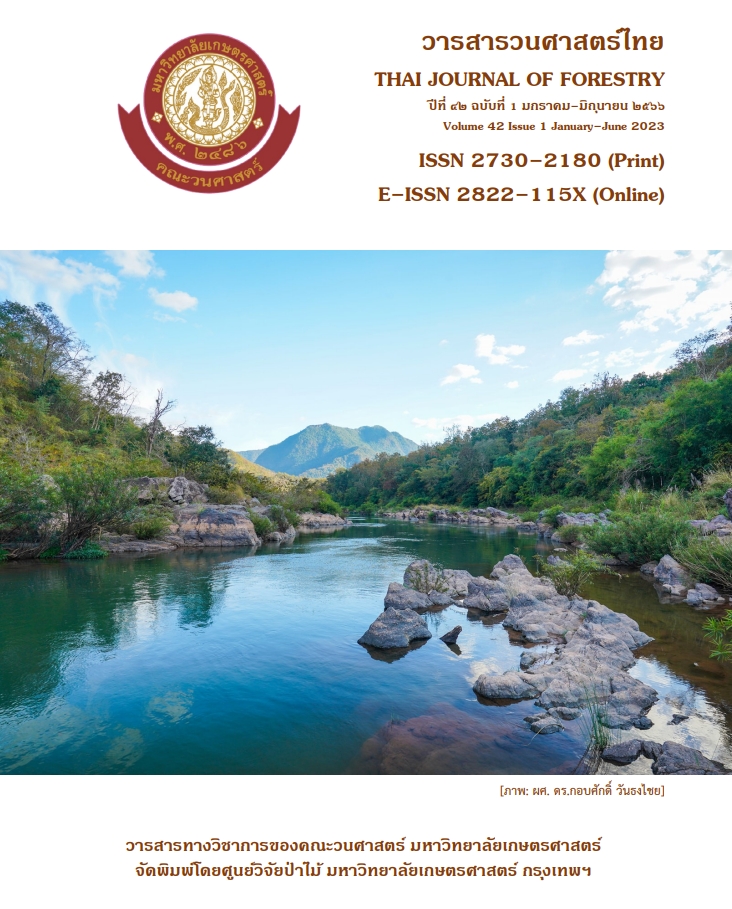การสำรวจไม้ต้นนอกเขตป่าโดยใช้การสุ่มตัวอย่างแบบเซกเตอร์: กรณีศึกษามหาวิทยาลัยเกษตรศาสตร์ วิทยาเขตบางเขน
Main Article Content
บทคัดย่อ
การศึกษานี้มีวัตถุประสงค์เพื่อศึกษาการประเมินพื้นที่หน้าตัดและเปรียบเทียบการประเมินพื้นที่หน้าตัดจากการสุ่มตัวอย่างแบบเซกเตอร์ในมหาวิทยาลัยเกษตรศาสตร์ วิทยาเขตบางเขน เนื้อที่ 707.740 ไร่ ซึ่งแบ่งออกเป็น 4 พื้นที่ย่อย ที่มีขนาด 55.810, 127.560, 256.550 และ 267.820 ไร่ และเก็บข้อมูลด้วยการสุ่มตัวอย่างแบบเซกเตอร์ โดยกำหนดมุม คือ 3, 5 และ 7 องศา กำหนดจุดศูนย์กลางของเซกเตอร์ตรงกลางของแต่ละพื้นที่ และสุ่มทิศทางเริ่มต้นด้วยการจับฉลาก วางแนวเซกเตอร์ถัดไปด้วยมุมฉาก รวม 4 เซกเตอร์ และการประเมินพื้นที่หน้าตัด พร้อมทั้งการวิเคราะห์ความแตกต่างทางสถิติด้วยการวิเคราะห์ความแปรปรวน
ผลการสำรวจ พบไม้ต้นที่มีเส้นผ่านศูนย์กลางเพียงอก มากกว่า 4.5 เซนติเมตร จำนวน 284 ต้น 57 ชนิด ผลการประเมินพื้นที่หน้าตัด ด้วยมุม 3, 5 และ 7 องศา พบว่า พื้นที่ย่อยที่ 1 มีค่า 69.685, 45.640 และ 35.350 ตารางเมตร ตามลำดับ พื้นที่ย่อยที่ 2 มีค่าประเมินพื้นที่หน้าตัด 80.732, 52.370 และ 39.625 ตารางเมตร ตามลำดับ พื้นที่ย่อยที่ 3 มีค่าประเมินพื้นที่หน้าตัด 23.955 , 30.278 และ 29.310 ตารางเมตร ตามลำดับ และพื้นที่ย่อยที่ 4 มีค่าประเมินพื้นที่หน้าตัด 80.688, 53.691 และ 49.839 ตารางเมตร ตามลำดับ ผลการวิเคราะห์ความแปรปรวน พบว่า พื้นที่หน้าตัดที่ประเมิน ด้วยมุม 3, 5, และ 7 องศา ในแต่ละพื้นที่ย่อย ไม่มีความแตกต่างกันอย่างมีนัยสำคัญทางสถิติ (P > 0.05) จึงเลือกมุมที่เหมาะสมในการสุ่มตัวอย่างในพื้นที่ย่อยที่ 1, 2, 3 และ 4 จากความคลาดเคลื่อนมาตรฐานที่มีค่าต่ำที่สุด คือ มุม 7, 7, 3 และ 7 องศา ตามลำดับ โดยมีค่า 28.123, 26.651, 6.633 และ 28.836 ตามลำดับ ข้อมูลที่ได้สามารถนำไปใช้ประกอบการตัดสินใจในการเลือกขนาดมุม เพื่อใช้ในการศึกษาในพื้นที่อื่น ๆ ต่อไป
Downloads
Article Details

อนุญาตภายใต้เงื่อนไข Creative Commons Attribution-NonCommercial-NoDerivatives 4.0 International License.
ข้าพเจ้าและผู้เขียนร่วม (ถ้ามี) ขอรับรองว่า ต้นฉบับที่เสนอมานี้ยังไม่เคยได้รับการตีพิมพ์และไม่ได้อยู่ในระหว่างกระบวนการพิจารณาตีพิมพ์ลงในวารสารหรือสิ่งตีพิมพ์อื่นใด ข้าพเจ้าและผู้เขียนร่วม (ถ้ามี) ยอมรับหลักเกณฑ์และเงื่อนไขการพิจารณาต้นฉบับ ทั้งยินยอมให้กองบรรณาธิการมีสิทธิ์พิจารณาและตรวจแก้ต้นฉบับได้ตามที่เห็นสมควร พร้อมนี้ขอมอบลิขสิทธิ์ผลงานที่ได้รับการตีพิมพ์ให้แก่วารสารวนศาสตร์ คณะวนศาสตร์ มหาวิทยาลัยเกษตรศาสตร์ กรณีมีการฟ้องร้องเรื่องการละเมิดลิขสิทธิ์เกี่ยวกับภาพ กราฟ ข้อความส่วนใดส่วนหนึ่ง หรือ ข้อคิดเห็นที่ปรากฏในผลงาน ให้เป็นความรับผิดชอบของข้าพเจ้าและผู้เขียนร่วม (ถ้ามี) แต่เพียงฝ่ายเดียว และหากข้าพเจ้าและผู้เขียนร่วม (ถ้ามี) ประสงค์ถอนบทความในระหว่างกระบวนการพิจารณาของทางวารสาร ข้าพเจ้าและผู้เขียนร่วม (ถ้ามี) ยินดีรับผิดชอบค่าใช้จ่ายทั้งหมดที่เกิดขึ้นในกระบวนการพิจารณาบทความนั้น”
เอกสารอ้างอิง
Chiriaco, M.V. 2010. On the Extension of Large-Scale Forest Inventories to Non - forest Areas.University of Tuscia, Viterbo, Italy.
Food and Agriculture Organization of the United Nations [FAO]. 2002. Trees Outside Forests Towards a Better Wariness. Rome, Italy.
Iles, K., Smith, N.J. 2006. A new type of plot that is particularly useful for sampling small clusters of objects. Forest Science, 52(2): 148–154.
Kaewbanjong, P., Prasomsin, P., Lumyai, P., Seenuil, W. 2021. Application of Point Sampling in Forest Inventory for Timber Assessment: A Case Study of Siamese Rosewood Plantation, Trat Province. Thai Journal of Forestry, 40(2): 172-186. (in Thai)
Kasetsart University. 2017. Kasetsart University, Bangkhen Campus. Campus Information. https://www.ku.ac.th/th/campus-information/, 25 April 2021.
Khunsathien, C. 2020. Timber Volume Assessment of Rubber Tree: A Case Study of Kanchanadit Plantation, Suratthani Province. M.S. Thesis, Kasetsart University. Bangkok, Thailand. (in Thai)
Lynch, T.B. 2006. Variance Reduction for Sector Sampling. Forest Science, 52(3): 251–261.
Prasomsin, P., Duangsathaporn, K. 2005. Field Forest Mensuration Handbook. Department of Forest Management, Faculty of Forestry, Kasetsart university, Bangkok, Thailand. (in Thai)
Senanarong, A. 1998. Perspective of planting big trees in the city. In: Documents for the Seminar on Planting Big Trees in the City. Forestry Research Center, Faculty of Forestry Kasetsart University, Royal Forest Department, Forestry Alumni Society, Bangkok, Thailand, pp. 1-6. (in Thai)
Seraj, M.H., Kiani, B. 2017. Efficiency of sector sampling for estimating juniper forest attributes vs. fixed area plot. Journal of Forest Science, 63(10): 463–469.
Smitinand, T. 1975. Wildflowers of Thailand. Aksornbandit Press, Bangkok, Thailand. (in Thai)
Sommeechai, M. 2009. Lecture Document on the Topic of Cities, Urban Communities, and Urban Environments. Department of Silviculture, Faculty of forestry, Kasetsart University, Bangkok, Thailand. (in Thai)
Smith, N.J., Iles, K. 2012. Sector Sampling–synthesis and applications. Forests, 3: 114 - 126.
The Forest Herbarium Royal Forest Department. 2001. Thai Plant Names. Prachachon Co., Ltd., Bangkok, Thailand. (in Thai)
Thaiutsa, B. 1995. Urban forest in National Tree Day 1995. Public Parks Division, Bangkok, Thailand. (in Thai)
Tipburee, P., Lumyai, P. 2021. Sector sampling method to survey trees outside forest area: A case study at the office of agricultural museum and culture, Kasetsart University. In: Proceedings of Forestry Conference 2021. Faculty of Forestry, Kasetsart University. Bangkok, Thailand, pp. 36- 45. (in Thai)
Tongson, P. 2011. Yield Assessment of Tree Resources Outside Forest by Using Sector Sampling Technique: A Case Study of Wachirabenchatat Park, Bangkok Metropolis. M.S. Thesis, Kasetsart University, Bangkok, Thailand. (in Thai)
Vanichbuncha, K. 2011. Statistics. Department of Statistics, Faculty of Commerce and Accountancy, Chulalongkorn University, Bangkok, Thailand. (in Thai)


